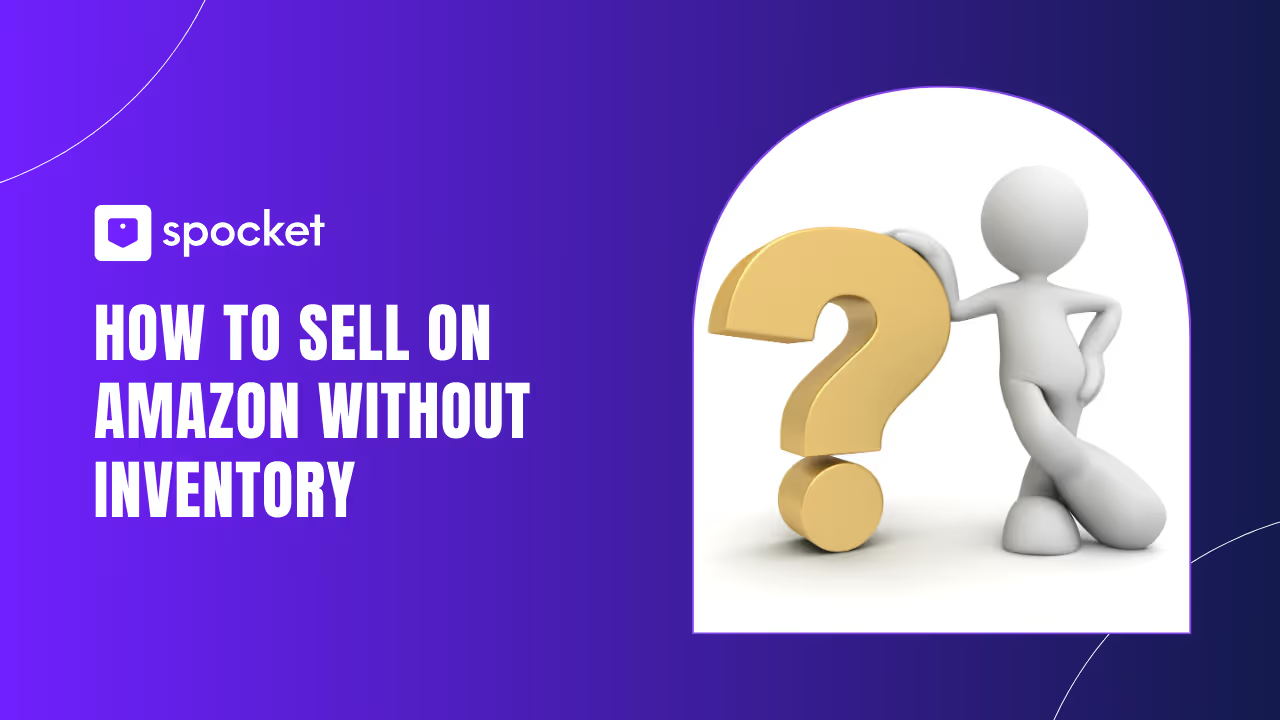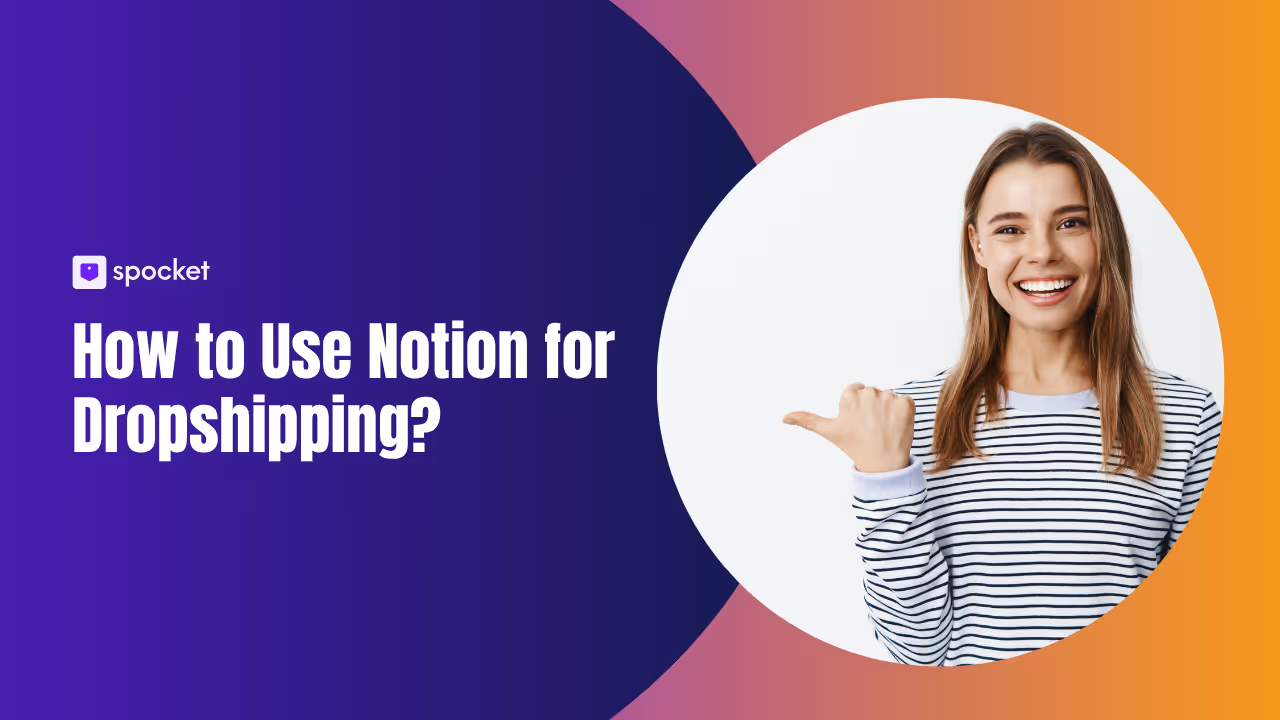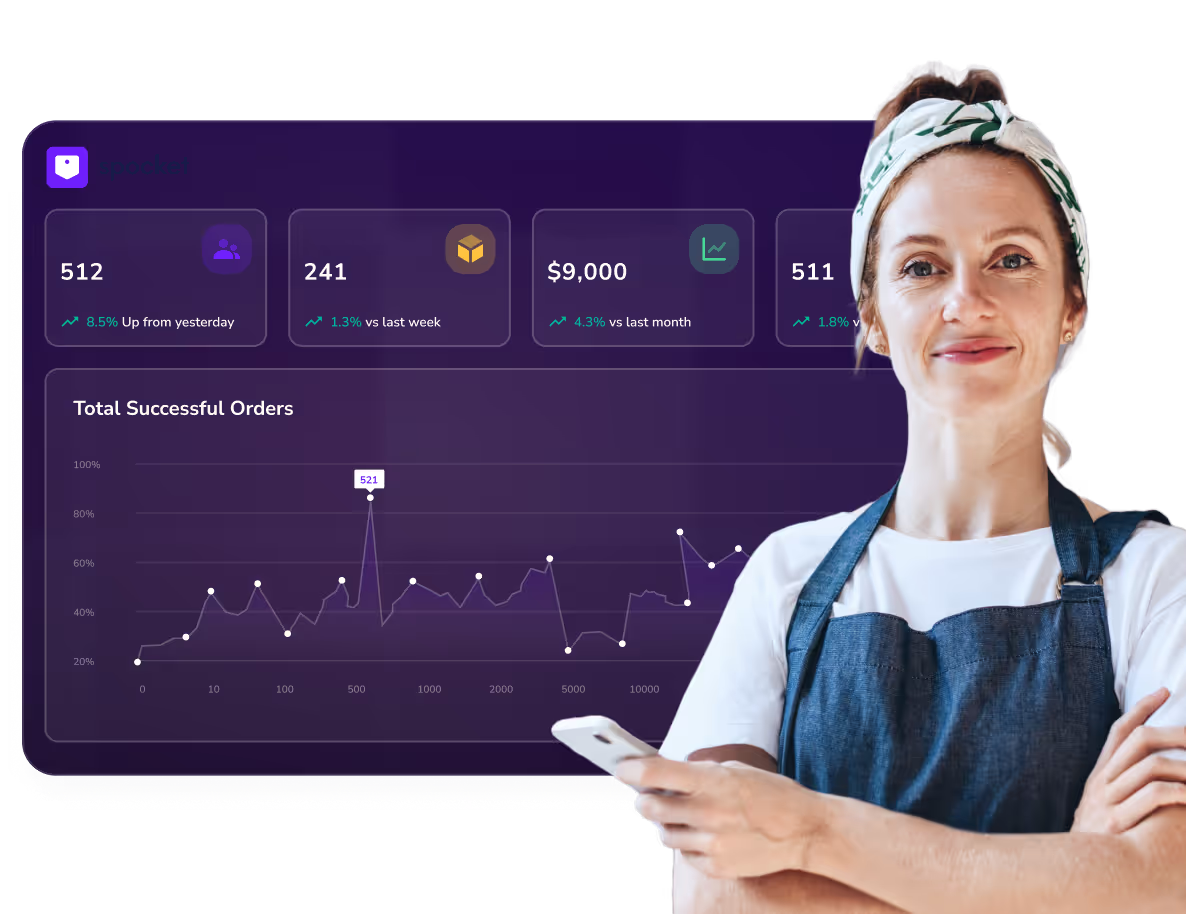Want to sell on Amazon but don’t want to deal with storing products? You’re in luck! There are multiple ways to sell on Amazon without inventory, making it easier than ever to start an online business with low investment.
You can use dropshipping on Amazon, sell custom products with print-on-demand, or earn through Amazon affiliate program earnings. If you prefer digital products, Amazon Kindle Direct Publishing is a great option.
This guide will walk you through the best way to sell on Amazon without inventory, helping you create a no-inventory Amazon business that generates passive income on Amazon. Let’s dive in and explore your options!
Can You Sell on Amazon Without Inventory?
Yes, you can sell on Amazon without inventory. Many sellers run successful businesses without ever handling physical stock. Amazon offers several business models that don’t require upfront inventory investment, making it easier to start selling with low risk.
By using dropshipping on Amazon, selling custom products through print-on-demand Amazon, or monetizing content via Amazon Kindle Direct Publishing, you can build a profitable no-inventory Amazon business. You can also earn commissions through the Amazon affiliate program earnings without ever owning a product.
Now, let’s break down how selling on Amazon without inventory works, whether it’s allowed, and the benefits of this approach.
How Selling Without Inventory Works
When you sell on Amazon without stock, you’re essentially acting as a middleman between suppliers and customers. Instead of storing and shipping products yourself, you rely on third-party services to fulfill orders.
Here are some of the most common methods:
- Dropshipping on Amazon: You list products on Amazon, and when a customer makes a purchase, the supplier ships it directly to them. You don’t hold any stock.
- Print-on-demand Amazon: You sell custom-designed products like T-shirts, mugs, and phone cases, and a third-party service prints and ships them when an order is placed.
- Amazon Kindle Direct Publishing: You can create and sell ebooks without printing or shipping anything. Readers buy and download your book instantly.
- Amazon affiliate program earnings: Instead of selling products directly, you promote Amazon products and earn commissions when customers buy through your referral links.
Each method offers flexibility, low startup costs, and a scalable way to generate passive income on Amazon.
Is It Legal and Allowed by Amazon?
Yes, Amazon allows sellers to use methods like dropshipping, print-on-demand, and digital product selling on Amazon. However, there are rules you must follow to stay compliant.
For dropshipping on Amazon, you must ensure that:
- Your business name is listed on all invoices and packaging.
- You are responsible for customer service and returns.
- You do not purchase products from another retailer and have them shipped to customers (this is against Amazon’s dropshipping policy).
For print-on-demand Amazon and Amazon Kindle Direct Publishing, Amazon fully supports these models as long as you follow copyright and content guidelines.
For Amazon affiliate program earnings, all you need to do is follow Amazon’s rules for product promotion and referrals.
As long as you follow Amazon’s policies, you can build a no-inventory Amazon business without any issues.
Benefits of Selling Without Stock
Choosing to sell on Amazon without inventory comes with several advantages, making it a great option for new and experienced sellers.
- Low startup costs: You don’t need to invest in inventory, storage, or warehousing.
- Less risk: No need to worry about unsold stock or wasted resources.
- Easy scalability: You can quickly expand your product catalog without upfront costs.
- Global selling opportunities: Sell to customers worldwide without managing logistics.
- Flexible business model: Whether it’s dropshipping, print-on-demand, or digital product selling on Amazon, you can choose a method that suits your skills and goals.
Best Methods to Sell on Amazon Without Inventory
If you want to sell on Amazon without inventory, you have multiple options. Some of the most popular methods include dropshipping on Amazon, selling print-on-demand Amazon products, publishing digital content through Amazon Kindle Direct Publishing, and earning commissions via Amazon affiliate program earnings.
Each method has its advantages, but dropshipping remains one of the easiest ways to start. It allows you to list and sell products without owning or storing them. Let’s dive into how it works.
1. Dropshipping on Amazon
Dropshipping on Amazon allows sellers to list products without holding inventory. Instead, when a customer places an order, a supplier ships the product directly to them. This means you never handle or store the goods yourself.

What is Dropshipping?
Dropshipping is a fulfillment model where you sell products without keeping any inventory. Instead, when a customer places an order on Amazon, you purchase it from a third-party supplier, who then ships it directly to the customer.
This means you don’t have to worry about storage, packaging, or shipping. You simply act as the middleman between the buyer and the supplier. Dropshipping on Amazon is a great way to start an online business with minimal risk.
How to Start Dropshipping on Amazon
Getting started with dropshipping on Amazon is fairly simple. Follow these steps:
- Create an Amazon Seller Account: Sign up as a seller and choose the Fulfillment by Merchant (FBM) option.
- Find Reliable Suppliers: Use platforms like AliExpress, Alibaba, or Spocket to source products.
- List Products on Amazon: Upload product details, pricing, and images.
- Manage Orders: When a customer buys your product, place the order with your supplier, who will then ship it directly to them.
- Handle Customer Service: Since you’re the seller, you must manage any customer inquiries, returns, or complaints.
To maximize success, choose high-demand, low-competition products. Optimize your listings with SEO-friendly descriptions and use professional images.
Pros and Cons of Dropshipping
Dropshipping is a popular no-inventory Amazon business model, but it has its challenges. Let’s look at the pros and cons.
Pros:
- Low startup cost: No need to invest in bulk inventory.
- No storage or shipping hassle: The supplier handles fulfillment.
- Flexible and scalable: You can add or remove products anytime.
- Test multiple niches: Easily experiment with different products.
Cons:
- Lower profit margins: Since suppliers handle fulfillment, you have less control over pricing.
- High competition: Many sellers use the same dropshipping model.
- Longer shipping times: If sourcing from overseas suppliers, customers may experience delays.
- Amazon policy restrictions: You must comply with Amazon’s dropshipping rules to avoid account suspension.
Despite the challenges, dropshipping on Amazon remains one of the best ways to sell on Amazon without inventory. It’s ideal for beginners who want to start selling without a significant upfront investment.
2. Print-on-Demand (POD) with Merch by Amazon
If you want to sell on Amazon without inventory but prefer a creative approach, print-on-demand Amazon is a great option. Instead of managing stock, you sell custom designs printed on products like T-shirts, hoodies, mugs, and phone cases. Merch by Amazon handles printing, shipping, and customer service, making it a hassle-free way to run a business.
POD is ideal for artists, designers, and entrepreneurs who want to sell unique products without upfront investment. It’s one of the best ways to build a no-inventory Amazon business and generate passive income on Amazon.

How Print-on-Demand Works on Amazon
Print-on-demand allows you to sell products without pre-purchasing inventory. You upload your design, list the product on Amazon, and when a customer buys it, Amazon prints and ships it for you.
Here’s how it works:
- Create a Merch by Amazon account: Sign up and wait for approval.
- Upload your designs: Amazon provides product templates to ensure your designs fit properly.
- Choose products: Select T-shirts, hoodies, phone cases, and other available items.
- Set your price: Amazon will display your product, and you earn a royalty per sale.
- Amazon prints and ships: Once a customer orders, Amazon handles printing and fulfillment.
Since Amazon takes care of everything, it’s one of the easiest ways to sell on Amazon without stock.
Steps to Start Selling POD Products
1. Sign up for Merch by Amazon: The first step is creating an account on Merch by Amazon. Amazon reviews applications, so be sure to provide relevant details about your experience or interest in selling custom products.
2. Design high-quality artwork: Your success depends on your designs. Use software like Adobe Illustrator, Canva, or Procreate to create eye-catching artwork. If you’re not a designer, you can hire freelancers from platforms like Fiverr or Upwork.
3. Select your products and pricing: Once your designs are ready, choose the products you want to sell. Amazon offers various clothing and accessory options. Set competitive prices that allow you to earn a good royalty while staying attractive to buyers.
4. Optimize your product listings: To maximize sales, use Amazon SEO techniques. Add relevant keywords like "funny graphic T-shirt" or "custom printed hoodie" to your titles and descriptions. This helps your products rank higher in searches.
5. Promote your designs: Since Merch by Amazon is highly competitive, promote your listings on social media, blogs, or YouTube. The more traffic you drive to your product page, the better your chances of making sales.
Pros and Cons of Print-on-Demand
Like any business model, print-on-demand Amazon has advantages and challenges.
Pros:
- No upfront inventory costs: You only pay when a product is sold.
- No shipping or fulfillment hassles: Amazon prints and ships orders for you.
- Scalable business model: You can upload unlimited designs and test different niches.
- Earn passive income on Amazon: Once your designs are live, they can generate sales continuously.
Cons:
- Approval required: Merch by Amazon isn’t open to everyone instantly.
- High competition: Many sellers are competing for attention.
- Limited product selection: Amazon offers fewer customization options compared to standalone POD platforms.
- Royalties vary: Amazon keeps a portion of sales, which can limit profit margins.
Despite the challenges, print-on-demand Amazon is an excellent way to sell on Amazon without inventory. If you’re creative and know how to market your designs, it can be a passive income stream that requires little ongoing effort.
3. Selling Digital Products on Amazon
If you want to sell on Amazon without inventory, digital products are a fantastic option. Unlike physical goods, digital products require no storage, shipping, or manufacturing. You create them once and sell them repeatedly, making them a great source of passive income on Amazon.
Amazon offers various ways to sell digital content, including Amazon Kindle Direct Publishing (KDP), music, audiobooks, and software. This method is ideal for writers, designers, and creators looking to monetize their expertise without handling stock.
What Digital Products Can You Sell?
Digital products are intangible goods that customers can download or access online. Here are some popular options for digital product selling on Amazon:
- Ebooks: Fiction, non-fiction, guides, and self-help books.
- Audiobooks: Narrated versions of books, uploaded via Audible’s ACX platform.
- Printables: Digital planners, journals, and templates.
- Software and Apps: Digital tools, plugins, and applications.
- Music and Sound Effects: Songs, beats, and sound files for content creators.
Since these products don’t require fulfillment by Amazon vs. dropshipping, they are one of the easiest ways to build a no-inventory Amazon business.
4. Amazon Kindle Direct Publishing (KDP)
If you enjoy writing, Amazon Kindle Direct Publishing allows you to publish ebooks and paperbacks without needing a publisher. It’s one of the best ways to sell on Amazon without stock while reaching a global audience.

Here’s how KDP works:
- Write and format your book: You can publish fiction, non-fiction, or educational material.
- Create an eye-catching cover: Use Amazon’s cover creator or hire a designer.
- Upload your manuscript: Submit your book file to Amazon Kindle Direct Publishing.
- Set your price: Choose a royalty percentage (35% or 70%) based on your book price.
- Publish and promote: Once approved, your book will be available for Kindle users worldwide.
Since Kindle books are instantly downloadable, you don’t need to handle shipping. Plus, you earn royalties every time someone purchases your book.
Steps to Sell Digital Products Successfully
Whether you’re selling ebooks, music, or printables, follow these steps to maximize sales:
- Choose a profitable niche: Research trending topics and customer demand.
- Create high-quality content: Ensure your digital product is valuable and well-designed.
- Optimize your product listing: Use Amazon SEO techniques to rank higher in search results.
- Set competitive pricing: Price your product reasonably to attract more buyers.
- Promote your digital product: Share it on social media, blogs, and email newsletters.
5. Earning with the Amazon Associates Program
If you want to sell on Amazon without inventory but don’t want to manage products at all, the Amazon Associates Program is a great option. It allows you to earn Amazon affiliate program earnings by promoting products and receiving a commission for every sale made through your referral links. This is a hands-off way to generate passive income on Amazon without worrying about storage, fulfillment, or customer service.
With Amazon’s massive product selection, you can find items in any niche, making it easy to create content around trending or high-demand products.
How Amazon’s Affiliate Program Works
The Amazon Associates Program is an affiliate marketing system that pays you a commission when someone buys a product through your unique tracking link. You don’t have to create, store, or ship products—you just promote them.
Here’s how it works:
- Sign up for Amazon Associates: Create a free account and get approved.
- Find products to promote: Search for items related to your niche.
- Generate your affiliate links: Amazon provides a custom link for each product.
- Share your links: Place them on blogs, social media, YouTube, or email newsletters.
- Earn commissions: When someone clicks your link and makes a purchase, you get paid.
Amazon offers commission rates that vary by product category. Some high-demand niches, like electronics and home goods, can be very profitable.
Steps to Monetize with Amazon Associates
To maximize your Amazon affiliate program earnings, follow these steps:
- Choose a niche: Focus on a category that aligns with your expertise, such as tech gadgets, beauty products, or home essentials.
- Build a platform: Start a blog, YouTube channel, or social media page to promote products.
- Write engaging content: Create product reviews, comparison articles, or buying guides.
- Optimize for SEO: Use relevant keywords so your content ranks on search engines.
- Use multiple channels: Share your affiliate links across different platforms to increase conversions.
If done right, affiliate marketing can become a steady passive income on Amazon without requiring direct involvement in the selling process.
Pros and Cons of Affiliate Marketing on Amazon
Like any business model, the Amazon Associates Program has its benefits and challenges.
Pros:
- No inventory needed: You don’t deal with stock, shipping, or customer service.
- Easy to start: Signing up is free, and anyone can join.
- Endless product selection: Promote thousands of Amazon items in any niche.
- Passive income: Once your content ranks, it can generate sales over time.
Cons:
- Lower commission rates: Amazon’s affiliate commissions are lower than other programs.
- Cookie duration is short: If a user doesn’t buy within 24 hours, you lose the commission.
- Dependent on Amazon’s policies: Changes to commission rates or program rules can affect earnings.
How to Get Started Selling Without Inventory
Selling on Amazon without stock is simple and requires minimal investment. Follow these steps to launch your no-inventory Amazon business successfully.
1. Setting Up Your Amazon Seller Account
- Sign up on Amazon Seller Central and choose an Individual or Professional account.
- Provide business details, payment info, and set up Fulfillment by Merchant (FBM) if needed.
2. Choosing a Profitable Product or Niche
- For dropshipping, pick trending, low-competition products.
- For print-on-demand Amazon, design for niche audiences.
- For Amazon Kindle Direct Publishing, create ebooks on popular topics.
- For Amazon affiliate program earnings, promote high-demand products.
3. Creating and Listing Your Products
- Optimize titles, descriptions, and images for Amazon SEO.
- Price products competitively to attract buyers.
4. Marketing and Driving Sales
- Use Amazon PPC ads, social media, and blogs to drive traffic.
- Offer promotions to boost sales.
5. Managing Orders and Customer Service
- If dropshipping on Amazon, ensure your supplier ships products on time.
- For print-on-demand Amazon, monitor order fulfillment and quality control.
- If selling digital products, provide clear instructions and handle any customer concerns.
Benefits of Selling on Amazon Without Inventory
Selling on Amazon without stock offers several advantages, making it a great option for beginners and experienced sellers.
Low Startup Costs: You don’t need to invest in bulk inventory. You only pay when a customer places an order, reducing financial risk.
No Storage or Fulfillment Worries: Since third-party suppliers or Amazon handle shipping, you avoid warehouse costs and logistics management.
Flexibility and Scalability: Easily add or remove products, test different strategies, and scale without inventory restrictions.
Global Selling Potential: Sell to international customers without managing overseas warehouses or shipping logistics.
Ability to Test Different Niches: Try out various products and niches with minimal risk before committing to a long-term business model.
Tips for Success When Selling Without Inventory
Selling on Amazon without stock can be profitable, but success requires strategy. Here are key tips to help you grow your no-inventory Amazon business efficiently.
1. Finding Reliable Suppliers for Dropshipping
Choosing the right supplier is crucial for dropshipping on Amazon. Look for vendors with fast shipping, quality products, and positive reviews. Platforms like AliExpress, Alibaba, and Spocket offer reliable suppliers. Always test products before listing them.
2. Optimizing Your Amazon Listings for Better Sales
Well-optimized listings attract more buyers. Use high-quality images, clear product titles, and detailed descriptions. Highlight key features and benefits to improve conversions. Pricing competitively also gives you an edge.
3. Using Amazon SEO to Rank Higher
Ranking high on Amazon search results increases visibility. Use relevant keywords in titles, bullet points, and descriptions. Research trending terms with Amazon Keyword Planner to find what customers are searching for.
4. Avoiding Common Pitfalls in No-Inventory Selling
Avoid long shipping times, low-quality products, and misleading descriptions. Be transparent with customers and provide great support to maintain positive reviews. Monitor your Amazon seller metrics to stay in good standing.
Conclusion
Selling on Amazon without inventory is a great way to start an online business with minimal risk. Whether you choose dropshipping on Amazon, print-on-demand, Amazon Kindle Direct Publishing, or affiliate marketing, there are multiple ways to generate passive income on Amazon without managing stock.
For high-quality dropshipping products, consider using Spocket, which offers fast shipping and reliable suppliers. Success comes from choosing the right niche, optimizing your listings, and providing great customer service. With the right strategy, you can build a no-inventory Amazon business that is scalable and profitable. Start today and grow your online brand effortlessly!







































